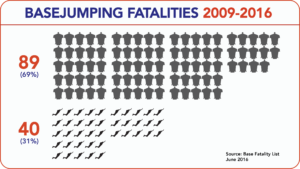I’m not the world’s best wingsuit pilot, not even close. Let’s just get that out of the way. My jump experience, skillset and numbers pale in comparison to most of those flying at the elite level around the world.
Yes, I have significantly more to learn; and yes, I’m enjoying the journey.
So, what do I bring to the table that’s so special? Built on a broad background of aviation experience, I bring a detail-oriented approach to wingsuit base (WB) that is desperately missing in our community.
What I lack in skill and proficiency, I offset with sound judgment and meticulous preparation.
I was fortunate enough to enter modern wingsuiting with a broad background of relevant expertise going back more than 20 years. An aeronautical engineering degree provided the theoretical side of aerodynamics and mechanics of number-crunching. Civilian flight school taught me the practical application and compromises of real-world aviation. Later, as a fighter pilot landing F-14 Tomcats on pitching aircraft carrier decks at night, I learned the payoffs of physical and mental preparation. I also learned the consequences of even the smallest of errors. The formalities of military funerals for my flight instructors and peers became morbidly routine, mostly from non-combat-related flight mishaps.
‘Carrier Aviation is not inherently dangerous; it’s just extremely unforgiving’
We would use this phrase to focus our priorities and mindset. Honestly, I think we were kidding ourselves. In truth, carrier aviation is both extremely dangerous and unforgiving. Unforgiving of even the most minute overlooked details in planning, of inadequate knowledge, improper training, poor execution, and most importantly, unforgiving of poor decision-making. On bad days, when shit really hit the fan and all emergency procedures were exhausted, lucky souls were saved courtesy of Martin-Baker ejection seats. Unlucky ones outside the envelope of even the best seats didn’t make it, usually as a result of pulling the ejection handle too late.
Like carrier aviation, WB requires minute attention to every detail, extensive and continual training, and precise execution of a comprehensive plan. WB exhibits all of the same dangerous and unforgiving traits of carrier aviation, if not more. Last time I checked, wingsuits don’t have afterburners and ejection seats to save your ass.
So, with most of the same flavors of associated risk, a careful observation of these two extreme communities could reasonably expect to find similarities in our approaches to risk mitigation, right?
Wrong. Nothing could be further from the truth. My observation is that the two communities are worlds apart in their approach to risk.
Carrier aviation teaches multiple backups for every procedure, meticulously briefed for every conceivable contingency (briefed because it has happened in the past, and can happen again in the future). Detailed emergency procedures (EPs) are burned into ‘brain stem power’ for reactions so fast that multi-step EPs are executed before pulse rates even flicker.
Brief the flight, and fly the brief. It’s called ‘Being a professional.’
What do I see in the WB community? Honestly, a bunch of cavalier basejumpers acting like 16-year-old kids who just found the keys to their dad’s Corvette.
Sometimes, I’ll see some basic attempts at pre-flight planning.
“Let’s do a quick morning load”
instead of
“We have to be geared up on exit no later than 10am because winds are forecast to switch up around 11”
The exit brief is usually brief (pun intended).
“I’ll exit first, you guys follow me”
instead of
“My exit direction is that house-sized boulder. Jumper 2 exits 5 degrees left of that boulder. Jumper 3 exits 5 degrees right of that boulder. Keep on your own side of me, no crossing over on this one. Now, here’s a practice count…”
More often, accident-response preparation is sadly thin.
“Is there cell signal up here?”
instead of
“In case anything unplanned happens, does everybody know I have this yellow ACR beacon in my leg wing pocket? In an emergency, response is initiated by pushing this button here…”
Overwhelmingly, I see a bunch of excited basejumpers who are stuck in old-school slick-jumper mentality. They zip into very-low-efficiency gliders, with minimal concepts of aerodynamics and energy management, and fly technical lines like they’re fueled by unlimited magic.
This amusement ride approach has become normal. Normal does not mean safe, correct or smart. Normal just means everybody is doing it, and mostly getting away with it.
Unfortunately, the statistics speak for themselves. Of 34 personal friends lost to basejumping (not counting aviation and skydiving), 25 were flying a wingsuit. That’s 75%. For a six-year span of 2009-2016, 89 out of 129 basejumping fatalities involved wingsuits. That’s two out of every three. (For the same period, USPA reported just 6 skydiving fatalities involving wingsuits.)
Of these WB fatalities, the leading probable cause overwhelmingly points to a phrase you will be hearing repeatedly here at Topgunbase: Pilot Error.
“Pilot error is the action or decision of the pilot that, if not caught or corrected, could contribute to the occurrence of an accident or incident, including inaction or indecision.” – FAA
Translation: “They knew better. Or should have.”
For those with a critical eye, it’s obvious that changes are needed. We need changes at a fundamental level, at a core mindset level, at an educational level. If we want to grow old in this cutting edge, high risk, emergent sport, we have to adapt and learn. Fast.

